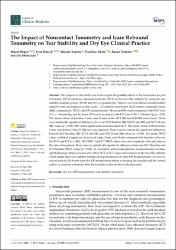| dc.contributor.author | Doğru, Murat | |
| dc.contributor.author | Şimşek, Cem | |
| dc.contributor.author | Kojima, Takashi | |
| dc.contributor.author | Aketa, Naohiko | |
| dc.contributor.author | Tsubota, Kazuo | |
| dc.contributor.author | Shimazaki, Jun | |
| dc.date.accessioned | 2022-06-06T13:59:26Z | |
| dc.date.available | 2022-06-06T13:59:26Z | |
| dc.date.issued | 2022 | en_US |
| dc.identifier.citation | Dogru, Murat et al. “The Impact of Noncontact Tonometry and Icare Rebound Tonometry on Tear Stability and Dry Eye Clinical Practice.” Journal of clinical medicine vol. 11,10 2819. 17 May. 2022, doi:10.3390/jcm11102819 | en_US |
| dc.identifier.uri | https://doi.org/10.3390/jcm11102819 | |
| dc.identifier.uri | https://hdl.handle.net/20.500.12809/10009 | |
| dc.description.abstract | The purpose of this study was to investigate the possible effects of the noncontact air puff tonometry (NCT) and Icare rebound tonometry (ICT) on the tear film stability by using the tear stability analysis system (TSAS) and dry eye parameters. Fifteen eyes from fifteen normal healthy subjects were investigated in this study. All subjects underwent TSAS surface regularity index (SRI) examinations, TBUT, and IOP measurements. The mean IOP results measured with NCT were 13.3 ± 1.86 mm Hg, and the mean IOP results measured with ICT were 15.88 ± 3.09 mm Hg (p > 0.05). The mean values of baseline, 5 min, and 10 min of the NCT-SRI and ICR-SRI were tested. There were statistically significant differences between NCT-Baseline SRI, NCT-5 min SRI, and NCT-10 min SRI values (p < 0.05). SRI values significantly increased after NCT. The mean values of the baseline, 5 min, and 10 min of the ICT-SRI were also assessed. There were no statistically significant differences between ICT-Baseline SRI, ICT-5 min SRI, and ICT-10 min SRI values (p > 0.05). The mean TBUT values exhibited a significant decrease at 1 min, 5 min, and 10 min compared with baseline values for the NCT and ICT (p < 0.01). NCT-TBUT and ICT-TBUT values were also compared with each other in the same time period. There were no statistically significant differences between NCT-Baseline and ICT-Baseline TBUT values (p > 0.05). In conclusion, intraocular pressure measurements in routine ophthalmology clinical practices by either NCT or ICT cause deterioration in the tear film stability which might affect tear stability testing when performed soon after IOP measurements. It is best to wait at least for 20-30 min after the IOP measurement before evaluating the tear film and the corneal surface or perform tonometry after the tear film-ocular surface evaluation tests. | en_US |
| dc.item-language.iso | eng | en_US |
| dc.publisher | MDPI | en_US |
| dc.relation.isversionof | 10.3390/jcm11102819 | en_US |
| dc.item-rights | info:eu-repo/semantics/openAccess | en_US |
| dc.subject | Dry eye | en_US |
| dc.subject | IOP measurement | en_US |
| dc.subject | Tear stability | en_US |
| dc.subject | Tonometer | en_US |
| dc.title | The Impact of Noncontact Tonometry and Icare Rebound Tonometry on Tear Stability and Dry Eye Clinical Practice | en_US |
| dc.item-type | article | en_US |
| dc.contributor.department | MÜ, Tıp Fakültesi, Cerrahi Tıp Bilimleri Bölümü | en_US |
| dc.contributor.institutionauthor | Şimşek, Cem | |
| dc.identifier.volume | 11 | en_US |
| dc.identifier.issue | 10 | en_US |
| dc.relation.journal | 2022 | en_US |
| dc.relation.publicationcategory | Makale - Uluslararası Hakemli Dergi - Kurum Öğretim Elemanı | en_US |


















